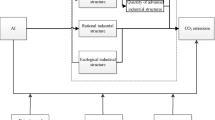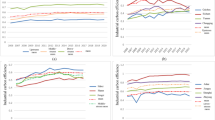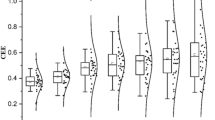Abstract
As an emerging technology, industrial intelligence focus on the integration of artificial intelligence and production, which creates a new access to achieve the goal of carbon emissions reduction. Using data on provincial panel data from 2006 to 2019 in China, we empirically analyze the impact and spatial effects of industrial intelligence on industrial carbon intensity from multiple dimensions. Results show an inverse proportionality between industrial intelligence and industrial carbon intensity, and the mechanism is to promote green technology innovation. Our results remain robust after accounting for endogenous issues. Viewed from spatial effect, industrial intelligence can inhibit not only the industrial carbon intensity of the region but also the surrounding areas. More strikingly, the impact of industrial intelligence in the eastern region is more obvious than that in the central and western regions. This paper effectively complements the research on the influencing factors of industrial carbon intensity and provides a reliable empirical basis for industrial intelligence to reduce industrial carbon intensity, as well as a policy reference for the green development of the industrial sector.


Similar content being viewed by others
Data Availability
The data will be made available on request from the corresponding author.
Notes
“Made in China 2025” was officially issued by the State Council of China on May 19, 2015. The theme of the policy is to promote the innovative development of China’s manufacturing industry and is focused on accelerating the depth of integration between the new generation of information technology and the manufacturing sector.
We used the consumption of eight fossil fuels such as coal, natural gas and coke in China’s provinces to calculate industrial CO2 emissions, based on the method in the IPCC National Greenhouse Gas Emission Inventory Guidelines 2006.
The Super-SBM model is used to measure China’s industrial carbon emission efficiency. The input indicators selected in this paper include labour force (number of people employed in industrial sectors by region), total capital (net value of industrial fixed assets above scale by region) and total energy (total energy consumption by region). The expected output indicator is selected from the main business income of industrial enterprises above the size of the sub-region. The undesired output is the sub-regional industrial co2 emissions.
References
Abeliansky AL, Prettner K (2021) Population growth and automation density: theory and cross-country evidence. VID Working Papers. https://doi.org/10.1553/0x003ce822
Acemoglu D, Restrepo P (2018) Artificial Intelligence, Automation, and Work. NBER Chapters
Acemoglu D, Restrepo P (2018) The race between man and machine: implications of technology for growth, factor shares, and employment. Am Econ Rev 108(6):1488–1542. https://doi.org/10.1257/aer.20160696
Acemoglu D, Lelarge C, Restrepo P (2020) Competing with Robots: Firm-Level Evidence from France. AEA Papers and Proceedings 110. https://doi.org/10.3386/w26738
Acemoglu D, Restrepo P (2020) Robots and jobs: evidence from US labor markets. J Political Econ 128(6):2188–224.4. https://doi.org/10.1086/705716
Aghion P, Jones B, Jones C, Agenda (2018) Artificial intelligence and economic growth. The Economics of Artificial Intelligence: An Agenda
Alavian P, Eun Y, Meerkov SM, Zhang L (2020) Smart production systems: automating decision-making in manufacturing environment. Int J Prod Res 58(3):828–845. https://doi.org/10.1080/00207543.2019.1600765
Andronie M, Lăzăroiu G, Iatagan M, Uță C, Ștefănescu R, Cocoșatu M (2021) Artificial intelligence-based decision-making algorithms, internet of things sensing networks, and deep learning-assisted smart process management in cyber-physical production systems. Electronics 10(20). https://doi.org/10.3390/electronics10202497
Anselin L (1989) What is special about spatial data? Alternative perspectives on spatial data analysis, Technical Report 89–4. Santa Barbara: National Center for Geographic information and Analysis. https://escholarship.org/uc/item/3ph5k0d4. Accessed 13-16 Dec 1988
Bag S, Pretorius JHC, Gupta S, Dwivedi YK (2021) Role of institutional pressures and resources in the adoption of big data analytics powered artificial intelligence, sustainable manufacturing practices and circular economy capabilities. Technol Forecast Soc Change 163:120420. https://doi.org/10.1016/j.techfore.2020.120420
Baldwin RE, Martin P, Ottaviano GI (2001) Global income divergence, trade, and industrialization: The geography of growth take-offs. J Econ Growth 6(1):5–37. https://doi.org/10.1023/A:1009876310544
Brynjolfsson E, Rock D, Syverson C (2018) Artificial intelligence and the modern productivity paradox: a clash of expectations and statistics, The economics of artificial intelligence: An agenda, University of Chicago Press, pp 23--57
Brynjolfsson E, Mitchell T (2017) What can machine learning do? Workforce Implications Sci 358(6370):1530–1534. https://doi.org/10.1126/science.aap806
Cioffi R, Travaglioni M, Piscitelli G, Petrillo A, De Felice F (2020) Artificial intelligence and machine learning applications in smart production: progress, trends, and directions. Sustainability 12(2):492. https://doi.org/10.3390/su12020492
Cockburn IM, Henderson R, Stern S (2018) The impact of artificial intelligence on innovation. Natl Bur Econ Res. https://doi.org/10.3386/W24449
Dong H, Xue M, Xiao Y, Liu Y (2021) Do carbon emissions impact the health of residents? Considering China’s industrialization and urbanization. Sci Total Environ 758:143688. https://doi.org/10.1016/j.scitotenv.2020.143688
Du K, Li J (2019) Towards a green world: How do green technology innovations affect total-factor carbon productivity. Energy Policy 131:240–250. https://doi.org/10.1016/j.enpol.2019.04.033
Fang K, Li C, Tang Y, He J, Song J (2022) China’s pathways to peak carbon emissions: new insights from various industrial sectors. Appl Energy 306:118039. https://doi.org/10.1016/j.apenergy.2021.118039
Foresti R, Rossi S, Magnani M, Bianco CGL, Delmonte N (2020) Smart society and artificial intelligence: big data scheduling and the global standard method applied to smart maintenance. Engineering 6(7):835–846. https://doi.org/10.1016/j.eng.2019.11.014
Fu H, Li GP, Zhu T (2021) Carbon emission of China’s manufacturing industry: industry differences and decomposition of driving factors. Reform 327(5):38–52
Giret A, Garcia E, Botti V (2016) An engineering framework for service-oriented intelligent manufacturing systems. Comput Indust 81:116–127. https://doi.org/10.1016/j.compind.2016.02.002
Graetz G, Michaels G (2015) Robots at Work. CEP Discuss Papers. https://doi.org/10.1162/rest_a_00754
Graetz G, Michaels G (2018) Robots at work. Rev Econ Stat 100(5):753–768
Gupta R, Srivastava D, Sahu M, Tiwari S, Ambasta RK, Kumar P (2021) Artificial intelligence to deep learning: machine intelligence approach for drug discovery. Mol Diversity 25(3):1315–1360. https://doi.org/10.1007/s11030-021-10217-3
Hermann M, Pentek T, Otto B (2016) Design principles for industrie 4.0 scenarios 3928--3937. https://doi.org/10.1109/HICSS.2016.488
Higón DA, Gholami R, Shirazi F (2017) ICT and environmental sustainability: a global perspective. Telematics Inform. https://doi.org/10.1016/j.tele.2017.01.001
Kamble S, Gunasekaran A, Dhone NC (2020) Industry 4.0 and lean manufacturing practices for sustainable organisational performance in Indian manufacturing companies. Int J Prod Res 58(5):1319–1337. https://doi.org/10.1080/00207543.2019.1630772
Korinek A, Stiglitz JE (2021) Artificial intelligence, globalization, and strategies for economic development. NBER Working Papers. https://doi.org/10.36687/inetwp146
Kumar M, Graham G, Hennelly P, Srai J (2016) How will smart city production systems transform supply chain design: a product-level investigation. Int J Prod Res 54(23):7181–7192. https://doi.org/10.1080/00207543.2016.1198057
Kusiak A (2017) Smart manufacturing must embrace big data. Nature 544(7648):23–25
Li M, Wang Q (2017) Will technology advances alleviate climate change? Dual effects of technology change on aggregate carbon dioxide emissions. Energy Sustain Dev 41:61–68. https://doi.org/10.1016/j.esd.2017.08.004
Liang S, Yang J, Ding T (2022) Performance evaluation of AI driven low carbon manufacturing industry in China: an interactive network DEA approach. Comput Ind Eng 170(1):108248. https://doi.org/10.1016/j.cie.2022.108248
Liu C, Zhang C (2015) The impact of ICT industry on CO2 emissions: A regional analysis in China. Renewable & sustainable energy reviews. https://doi.org/10.1016/j.rser.2014.12.011
Liu Y, Feng C (2020) Decouple transport CO2 emissions from China’s economic expansion: a temporal-spatial analysis. Transp Res Part D: Trans Environ 79:102225. https://doi.org/10.1016/j.trd.2020.102225
Liu J, Chang H, Forrest JY, Yang B (2020) Influence of artificial intelligence on technological innovation: evidence from the panel data of china’s manufacturing sectors. Technol Forecast Soc Change 158:120142. https://doi.org/10.1016/j.techfore.2020.120142
Liu J, Liu L, Qian Y, Song S (2022) The effect of artificial intelligence on carbon intensity: evidence from China’s industrial sector. Socio-Econ Plan Sci 83:101002. https://doi.org/10.1016/j.energy.2014.01.060
Mahmood H, Alkhateeb TTY, Furqan M (2020) Industrialization, urbanization and CO2 emissions in Saudi Arabia: Asymmetry analysis. Energy Reports 6:1553–1560. https://doi.org/10.1016/j.egyr.2020.06.004
Mao S, Wang B, Tang Y, Qian F (2019) Opportunities and challenges of artificial intelligence for green manufacturing in the process industry. Engineering 5(6):995–1002. https://doi.org/10.1016/j.eng.2019.08.013
Mao W, Wang W, Sun H (2019) Driving patterns of industrial green transformation: a multiple regions case learning from China. Sci Total Environ 697:134134. https://doi.org/10.1016/j.scitotenv.2019.134134
Mehmetoglu M (2018) Medsem: A Stata package for statistical mediation analysis. Int J Comput Econ Econ 8(1):63–78. https://doi.org/10.1504/IJCEE.2018.088321
Moyer JD, Hughes BB (2012) ICTs: Do they contribute to increased carbon emissions? Technol Forecast Soc Change 79(5):919–931. https://doi.org/10.1016/j.techfore.2011.12.005
Nguyen TT, Pham TAT, Tram HTX (2020) Role of information and communication technologies and innovation in driving carbon emissions and economic growth in selected G-20 countries. J Environ Manage 261:110162. https://doi.org/10.1016/j.jenvman.2020.110162
Ouyang X, Lin B (2015) An analysis of the driving forces of energy-related carbon dioxide emissions in China’s industrial sector. Renew Sustain Energy Rev 45:838–849. https://doi.org/10.1016/j.rser.2015.02.030
Peng X (2020) Strategic interaction of environmental regulation and green productivity growth in China: green innovation or pollution refuge? Sci Total Environ 732:139200. https://doi.org/10.1016/j.scitotenv.2020.139200
Plepys A (2002) The grey side of ICT. Environ Impact Assess Rev 22(5):509–523. https://doi.org/10.1016/S0195-9255(02)00025-2
Tobler WR (1970) A computer movie simulating urban growth in the Detroit region. Econ Geogr 46(02):234–240
Wang N, Chang Y (2014) The evolution of low-carbon development strategies in China. Energy 68:61–70. https://doi.org/10.1016/j.energy.2014.01.060
Wang SS, Zhou DQ, Zhou P, Wang QW (2011) CO2 emissions, energy consumption and economic growth in China: a panel data analysis. Energy Policy 39(9):4870–4875. https://doi.org/10.1016/j.enpol.2011.06.032
Wang S, Fang C, Haitao MA, Wang Y, Qin J (2014) Spatial differences and multi-mechanism of carbon footprint based on GWR model in provincial China. J Geog Sci 24(4):19. https://doi.org/10.1007/s11442-014-1109-z
Wang C, Engels A, Wang Z (2018) Overview of research on China’s transition to low-carbon development: the role of cities, technologies, industries and the energy system. Renew Sustain Energy Rev 81:1350–1364. https://doi.org/10.1016/j.rser.2017.05.099
Wang Y, Yang H, Sun R (2020) Effectiveness of China’s provincial industrial carbon emission reduction and optimization of carbon emission reduction paths in “lagging regions”: efficiency-cost analysis. J Environ Manage 275:111221. https://doi.org/10.1016/j.jenvman.2020.111221
Wei T, Liu Y (2017) Estimation of global rebound effect caused by energy efficiency improvement. Energy Econ 66:27–34. https://doi.org/10.1016/j.eneco.2017.05.030
Xu LD, Xu EL, Li L (2018) Industry 4.0: state of the art and future trends. Int J Prod Res 56(8):2941–2962. https://doi.org/10.1080/00207543.2018.1444806
Funding
This work received financial support from research on stability of industry-university research coupling symbiosis network of oil and gas re-source-based cities (no.19JYB139), and Research on the Evaluation and Realization Path of the Coupled and Coordinated Development of “Water-Energy-Grain” Linkage System in Heilongjiang Province (no. 21JYB139)Data availability The datasets generated and/or analyzed during the current study are property of the National Bureau of Statistics; they are available from the corresponding author who will inform the National Bureau of Statistics that the data will be released on reasonable request.
Author information
Authors and Affiliations
Contributions
Sijia Tao conceived and designed the research question and wrotethe paper. Yanqiu Wang and Yingnan Zhai reviewed and edited the manuscript. All authors read and approved the manuscript.
Corresponding author
Ethics declarations
Ethics approval and consent to participate
Not applicable.
Consent for publication
Not applicable.
Conflict of interest
The authors declare no competing interests.
Additional information
Responsible Editor: Ilhan Ozturk
Publisher's note
Springer Nature remains neutral with regard to jurisdictional claims in published maps and institutional affiliations.
Rights and permissions
Springer Nature or its licensor (e.g. a society or other partner) holds exclusive rights to this article under a publishing agreement with the author(s) or other rightsholder(s); author self-archiving of the accepted manuscript version of this article is solely governed by the terms of such publishing agreement and applicable law.
About this article
Cite this article
Tao, S., Wang, Y. & Zhai, Y. Can the application of artificial intelligence in industry cut China’s industrial carbon intensity?. Environ Sci Pollut Res 30, 79571–79586 (2023). https://doi.org/10.1007/s11356-023-27964-5
Received:
Accepted:
Published:
Issue Date:
DOI: https://doi.org/10.1007/s11356-023-27964-5




